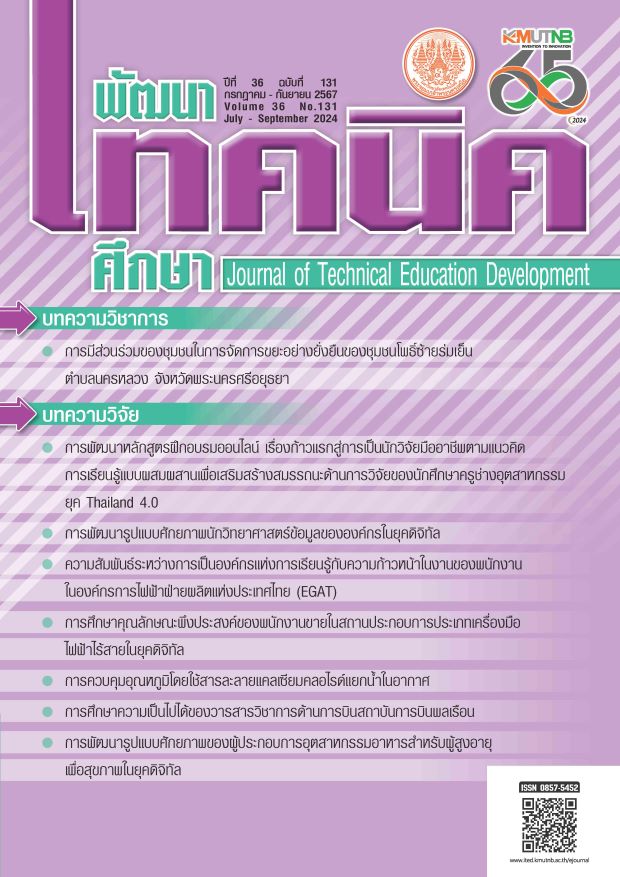The Development of Stone Crushing Plant and Quarrying Industry’s Management Model for Competitiveness
Main Article Content
Abstract
The objectives of this research were 1) to investigate key components of a management model in relation to stone crushing plant and quarrying industry as to strengthen business competitiveness; 2) to develop a management model; and 3) to create a professional user manual of the management model. This research was carried out using a mixed-methods approach. Research instruments for data collection consisted of semi-structured, in-depth interview questions and questionnaires. Ten professional experts served as participants for in-depth interviews whereas 297 management staff members associated with crushing plant and quarrying industry were respondents of the survey. Statistical methods used for data analysis comprised frequency, percentage, mean, and standard deviation whereas exploratory factor analysis (EFA) was applied to uncover the underlying factor structure. The developed management model was evaluated by 15 experts in a focus group discussion and the draft of manual handling guidance was evaluated by a panel of 5 specialists.
As results, the investigated management model encompasses 5 key dimensions and 14 components. The 5 critical dimensions with their competency-based components are as follows: 1) Organization Efficiency, with its constituting elements of management processes, management characteristics, technology & differentiation along with trade alliances; 2) Intellectual Capital, with its constituting elements of workers, machines and safety; product quality and advantages, financial management, combined with advertising, pricing and outsourcing; 3) Social Capital, with the constituting elements of social responsibility and community relations; 4) Environment, with respective constituting elements of environmental management and engagement in environmental projects and standards; 5) Government and government regulations, with constituent elements of legal competence in applicable laws and regulations coupled with maintaining strong ties with the government sector. The developed management framework and the handbook were unanimously approved by the expert panel. Eventually, the crafted guidance manual was adopted by employees within 5 quarry production stone crusher plant manufacturers. The findings unveiled that the average user satisfaction rating reached 4.88 out of 5.0, implying a very high level of satisfaction in the mind of its users.
Article Details

This work is licensed under a Creative Commons Attribution-NonCommercial-NoDerivatives 4.0 International License.
References
สำนักงานพัฒนารัฐบาลดิจิทัล (องค์การมหาชน), รายได้ต่อหัวของประชากร. (2563). [ออนไลน์]. [สืบค้นวันที่ 17 ธันวาคม 2563]. จาก https://opend.data.go.th/search_virtuoso/after/index.jsp?language=th&dsname=vir_2941_1583063478&path=vir_2941_1583063478
ฝ่ายเศรษฐกิจและวิชาการ สภาอุตสาหกรรมแห่งประเทศไทย. (2564). เผยโฉม 15 อุตสาหกรรมทรง-ทรุด-ฟื้นตัวชี้ปี 2563 ปีทองของอาหาร [ออนไลน์]. [สืบค้นวันที่ 28 มกราคม พ.ศ. 2564]. จาก https://www.wearecp.com/new-year63-e-001/
สำนักงานคณะกรรมการนโยบายเขตพัฒนาพิเศษภาคตะวันออก. (2564). ทำไมต้อง อีอิซี ความเป็นมาของ อีอีซี. [ออนไลน์]. [สืบค้นวันที่ 5 มีนาคม 2564]. จาก https://www.eeco.or.th/th/government-initiative/why-eec
กรมอุตสาหกรรมพื้นฐานและการเหมืองแร่. (2563). โรงงานโม่ บด และย่อยหิน. [ออนไลน์]. [สืบค้นวันที17 ธันวาคม 2563]. จาก http://www1.dpim.go.th/csh/cr.php
ธนกร จันทาคึมบง, หฤษฎ์ สุภักดี และ ศิริลักษณ์ วรไวย์. (2564). การประยุกต์ใช้ทฤษฎีการบริหารจัดการ POCCC ของอาสาสมัครประจำครอบครัวเพื่อป้องกันโรคไข้เลือดออก. วารสารวิชาการสาธารณสุข. ปีที่ 30 ฉบับเพิ่มเติม 1 พฤษภาคม-มิถุนายน 2564. S65-S75.
Sehnem, S., Piekas, A., Bau, C. Magroc, D. Fabris, J. and Leite, A. (2020). Public policies, management strategies, and the sustainable and competitive management model in handicrafts. Journal of Cleaner Production, 266(2020), 121695.
เกียรติพงษ์ อุดมธนะธีระ และ กัญญามน กาญจนาทวีกูล. (2563). แนวทางการพัฒนาการจัดการเทคโนโลยีสารสนเทศ เพื่อเพิ่มศักยภาพการจัดการโซ่อุปทานอุตสาหกรรมโรงโม่บดและย่อยหิน. วารสารวิชาการ สถาบันเทคโนโลยีแห่งสุวรรณภูมิ. 302-318.
กรธวัฒน์ สกลคฤหเดช และสุมนา จันทราช (2562) การเพิ่มขีดความสามารถทางการแข่งขันจากการสร้างพันธมิตรทางธุรกิจของธุรกิจการกีฬาในประเทศไทย. วิทยาลัยพณิชยศาสตร์บูรพาปริทรรศน์. 14 (1), 90-103.
Zhong, X. R. (2013). Construction safety accident prevention research based on 3E principle. In Applied Mechanics and Materials (Vol. 353, pp. 2867-2871). Trans Tech Publications Ltd.
Bak, P. (2012). Selected aspects of financial planning at mining companies. AGH Journal of Mining and Geoengineering. 36(3)(2012): 49-55.
Adomako, S and Tran, M.D. (2022). Sustainable environmental strategy, firm competitiveness, and financial performance: Evidence from the mining industry. Resources Policy. 75(2022), 102515.
Gilbert G., Hiqmatus S., and Filson M. S. (2019). Implementation of ISO 9001:2015 and ISO 14001:2015 in coal and heavy metal mining sector: Study case on Developed and Developing County. Jurnal Sains dan Teknologi Lingkungan. 11(2019), 57-73.
Bruno, V. and Claessens, S. (2010). Corporate governance and regulation: Can there be too much of a good thing?. Journal of Financial Intermediation. 19 (4)(2010): 461-482.
Schommer, P. C., Rocha, A. C., Spanio, E. L., Dahmer, lJ., and Sousa, A. D. (2015). Accountability and co-production of information and control: social observatories and their relationship with government agencies. Revista de Administração Pública. 49(6)(2015): 1375-1400.


